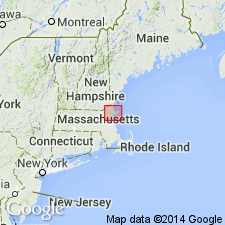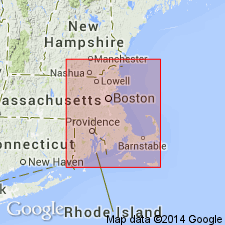
- Usage in publication:
-
- Peabody batholith*
- Modifications:
-
- Named
- Dominant lithology:
-
- Granite
- AAPG geologic province:
-
- New England province
Summary:
Named for Peabody, Essex Co., northeasternmost MA. Igneous rocks in Essex Co. have been separated into two groups, the alkaline and subalkaline. The older group, subalkaline, consists of granites, granodiorites, quartz diorites, gabbro-diorites, and gabbros that are greatly metamorphosed. The younger group, alkaline, which are intrusive into the older group, consists chiefly of alkaline granites and alkaline and nepheline syenites with some diorite, diabase, and gabbro and are relatively unaltered. The Peabody batholith is considered a stock of the Quincy granite. The Peabody forms a roughly circular stock or small batholith measuring 3.5 to 5.5 miles. To the northeast it underlies the greater part of the town of Beverly and Manchester and forms part of the large Cape Ann batholith.
Source: GNU records (USGS DDS-6; Reston GNULEX).

- Usage in publication:
-
- Peabody Granite*
- Modifications:
-
- Overview
- AAPG geologic province:
-
- New England province
Summary:
The Peabody Granite forms a stock of roughly elliptical ground plan having an area of about 15 square miles. The granites of the alkalic group have generally been mapped as Quincy Granite because of their probable correlation with granites at Quincy, MA. The petrographic similarities between the granites of Essex Co. (including the Peabody) and the Quincy Granite are much more striking than their differences, and general correlation of the two groups seems justified. However, since the two areas are 20 miles apart and there are some differences, the name Quincy should not be used in Essex Co. Therefore, the name Peabody Granite is revived.
Source: GNU records (USGS DDS-6; Reston GNULEX).

- Usage in publication:
-
- Peabody Granite*
- Modifications:
-
- Age modified
- Geochronologic dating
- AAPG geologic province:
-
- New England province
Summary:
The Peabody Granite is radiometrically dated at about 380 Ma (late Early Devonian through early Late Devonian). Earlier age estimates ranged from Carboniferous to Permian.
Source: GNU records (USGS DDS-6; Reston GNULEX).

- Usage in publication:
-
- Peabody Granite*
- Modifications:
-
- Age modified
- AAPG geologic province:
-
- New England province
Summary:
Peabody Granite was thought to be same age as Quincy Granite and former Cape Ann Granites by Zartman and Marvin (1971) on basis of radiometric age determinations using several methods. Subsequent work by R.E. Zartman (1979, oral commun.) indicates that Peabody is approx 370 m.y. old; age is therefore changed to Middle Devonian.
Source: GNU records (USGS DDS-6; Reston GNULEX).

- Usage in publication:
-
- Peabody Granite*
- Modifications:
-
- Overview
- AAPG geologic province:
-
- New England province
Summary:
Used as Peabody Granite of Middle Devonian age. Consists of alkalic granite containing ferro-hornblende. Intrudes Proterozoic Z unnamed gabbro and more mafic part of Dedham Granite.
Source: GNU records (USGS DDS-6; Reston GNULEX).

- Usage in publication:
-
- Peabody Granite*
- Modifications:
-
- Overview
- Geochronologic dating
- AAPG geologic province:
-
- New England province
Summary:
The Peabody Granite occurs in two plutons that total about 50 square kilometers. The large mass at Peabody (Peabody pluton) is the main body. The smaller mass near Reading (Reading pluton) is lithologically similar to the Peabody pluton. Both masses intrude the rocks of the Late Proterozoic mafic volcanic-plutonic complex. Although the major minerals and bulk composition of the Quincy, Cape Ann, and Peabody Granites are similar, their petrography, fabric, and ages of intrusion indicate distinct magmatic events. The occurrence of aplite and pegmatite in the Peabody distinguishes it from the Cape Ann Complex. Devonian age is based on Rb-Sr whole-rock age of 359 +/-24 Ma (Zartman and Marvin, 1971) and U-Pb zircon age of 395 +/-20 Ma (Zartman, 1977).
Source: GNU records (USGS DDS-6; Reston GNULEX).
For more information, please contact Nancy Stamm, Geologic Names Committee Secretary.
Asterisk (*) indicates published by U.S. Geological Survey authors.
"No current usage" (†) implies that a name has been abandoned or has fallen into disuse. Former usage and, if known, replacement name given in parentheses ( ).
Slash (/) indicates name conflicts with nomenclatural guidelines (CSN, 1933; ACSN, 1961, 1970; NACSN, 1983, 2005, 2021). May be explained within brackets ([ ]).

